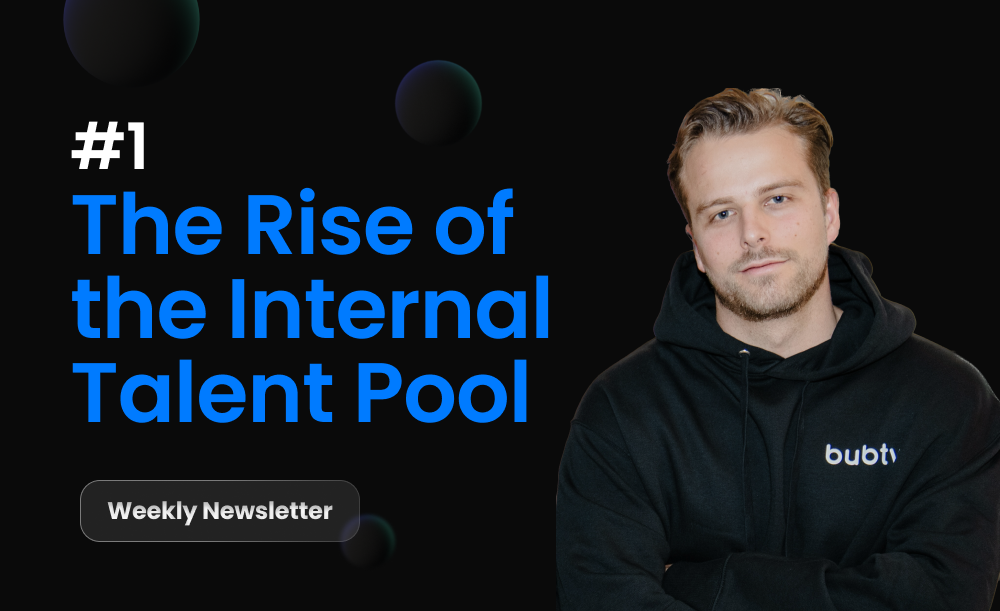Welcome to my first-ever newsletter. I am so grateful you subscribed and I am beyond excited to bring you the first edition of our
Weekly Talent Pool Deep Dives, landing in your inbox every Friday.
This week, we're jumping right into why internal talent pools are set to shake up hiring practices in the next year.
The eye-opening journey of talent pools.
‘I once built a list of 300 high-quality vetted freelancers in less than 2 months. And it wasn’t rocket science.’
To truly understand how we made this happen, I'll have to take you back to the very beginning. So, grab a cup of coffee and settle in for a trip down memory lane.
Let's rewind to 2018. It was a day like any other, and I was stepping into a shared office space for my day's work. My eyes were drawn to a familiar face, someone seated next to me. That person was Benjamin, my old best friend. We had not crossed paths for about a decade. Time and distance have a way of pulling people apart, and that's what happened to us. We moved to different parts of the city, enrolled in different schools, and essentially, lived separate lives.
Seeing Benjamin in the office that day was unexpected, and at first, I barely recognized him. After all, he was no longer the 11-year-old boy I used to know. Benjamin had grown, and so had I. The transition from 11 to 21 is a significant one, and it had transformed us both. Yet, something about him seemed familiar. I mustered up the courage and asked, "Are you Ben?" There was a moment of confusion, possibly due to my new bearded look, but as we began to reminisce about our shared past, the realization dawned upon him. We were once inseparable, and that bond, despite the years and distance, remained intact.
Back then, Benjamin was laying the groundwork for his own development agency. His exceptional talent had earned him a reputation, and there was a high demand for his services. To handle the workload, he started outsourcing his tasks to freelancers. Interestingly, I was in a similar position as a marketing freelancer, swamped with more work than I could handle.
Our unexpected reunion quickly transformed into a whirlwind of brainstorming sessions. We discovered that our visions aligned perfectly. We were both filled with an insatiable drive to create something impactful. It was not about the money; it was about the journey, the process, the experience of building something from the ground up. We sealed our newfound partnership with a handshake, promising to make our ambitious dream a reality.
The following months saw us collaborate on several projects without any official agency name. We gained more understanding and comfort with the freelancing ecosystem with each project. The idea of establishing our own team of freelancers to assist us in managing our workload started to take shape.
I kickstarted the process by hiring a freelancer from Fiverr for designing a logo. But when we noticed we were paying a 20% markup on every project, we decided it was time to build our own talent pool - a ready-to-deploy team of freelancers for all our projects.
In no time, we had a team of 300 highly skilled freelancers. Our projects ranged from local eateries to multinational corporations. However, managing such a vast and diverse group posed its challenges.
We worked on many different projects, from helping small local restaurants to big corporate companies. But as the projects grew bigger, they also became more complex.
Most of our freelancers were developers, and with Benjamin's background in business engineering and development, we had an ‘aha’ moment.
we thought we could build our own platform. A one-stop shop for hiring, managing projects, our Talent pool, and handling our payments.
But, building our own platform was not as easy as we thought. Yes, we built something insane, but it also took a lot of our time and resources. And diverted our focus.
That’s when the real light bulb moment hit us.
As the freelance workforce outruns the employees coming years, more companies will need a platform to manage this new hiring process.
Then 2020 hit, bringing the pandemic with it. Benjamin and I found a tiny office, barely bigger than a broom closet: our only decor - two desks and a coffee machine perched on the windowsill. We decided to change our course and started our journey with Bubty(See picture)

Our goal with Bubty was simple - help companies build and manage their talent pools using top-notch technology. Today, in 2023, our platform powers dozens of companies and agencies and over 35.000 talents.
But our conviction in the power of Talent Pools transcends our personal experience.
The question arises: why do we, with such unwavering confidence, declare Talent Pools as the future of every company’s workforce...
Here is why:
The Market Domino of Correlations
When I first dipped my toes in the vast ocean of the contingent workforce industry, I remember feeling slightly overwhelmed. Navigating through this realm brimming with data, reports, trends, and an ever-changing landscape of knowledge was no mean feat. What I sought was a human perspective
After reading through thousands of reports and articles, engaging in enlightening discussions with industry experts, and gaining first-hand experience on the benefits of certain strategy improvements from all different angles…
There was one thing that stood out to me to play the most prominent part in the workforce of the future:
Talent pools
And based on all my 10.000 hours of research, I'd like to outline some market correlations that have led 2023 to be coined as the year of the Internal Talent Pool.
Because When you take a step back and look at the bigger picture... everything just seems to click into place.
- The first domino to tip was the mounting challenge of hiring and retaining top talent. According to industry leaders, Recent data from a PWC survey revealed that this issue has become so significant that it's now considered the second most substantial risk to businesses.
- A significant part of this challenge is due to the rapidly evolving nature of talent. Today, 1.57 billion people across the globe identify as freelancers, representing almost 47% of the global workforce.
- This seismic shift towards a more contingent workforce has disrupted traditional talent acquisition models and pushed companies to explore alternative strategies.
- Then came the rise of talent marketplaces. They flourished due to the increased difficulty and costs associated with external talent recruitment. However, this trend only served as a Band-Aid, patching over the deeper issues companies were facing in acquiring and retaining top-notch talent.
Enter the era of Internal Talent Pools. - With the high markups charged by third-party agencies and the dearth of visibility within the talent pool, companies have realized the value of nurturing and leveraging their own. High-performing organizations are more inclined to invest in internal mobility, seeing it as a critical talent initiative.
Examples of companies benefiting from this approach. Was an article I read about Schneider Electric, they saw a marked improvement in worker retention after implementing an Internal Talent Pool. Similarly, Teach For America was able to increase retention by as much as 12% using an Internal Talent Pool.
Today, more and more companies are recognizing the importance of fostering a culture of internal mobility, cultivating their internal talent pools, and integrating their talent acquisition function with broader HR strategies. With these elements working in tandem, companies can enhance talent engagement, reduce staffing & recruitment costs, and ultimately:
turn a cost into an ecosystem into an asset
And numbers are not the only thing driving this domino of accurate statistics. This is what the actual experts have to say about it:
The Future is Talent Pools, Says Dustin Talley
In a recent episode of our podcast, Dustin Talley, the founder of Talent Simplified, shared valuable insights into the future of talent acquisition. One of his standout observations? The vital importance of talent pools.
Talley expressed a clear viewpoint: "I've been saying for a long time that 'everyone needs a talent pool.' Public and private talent pools offer a proactive approach to a sometimes reactive industry."
His company, Direct Collective, is already trailblazing with a contingent labor expert talent pool, showing us firsthand how these talent reservoirs can tap into the rising demand for independent work and connect experts to the right opportunities.
As Talley concludes, proactive strategies like talent pools aren't just important today—they're shaping the future of work.
Want more insights from Dustin Talley? Catch the full episode of our podcast [here] for a deeper dive into the revolution of talent acquisition and the vital role talent pools are set to play.
Closing Thoughts
In the end, the beauty of Internal Talent Pools lies not just in the host of benefits they offer, but in the fact that they represent a shift towards a more sustainable, scalable, and efficient model of talent acquisition and management. By looking inward, we're paving the way for a future where talent is recognized, nurtured, and deployed most effectively.
As this wave of change sweeps across the business landscape, are you ready to ride it? The choice, as always, is in your hands.
Until next time,
Remember, if you want to dive deeper into any of these topics, you can always catch me here: https://www.linkedin.com/in/lee-willoughby-997899182/
See you next week for another deep dive into the world of talent pools!





